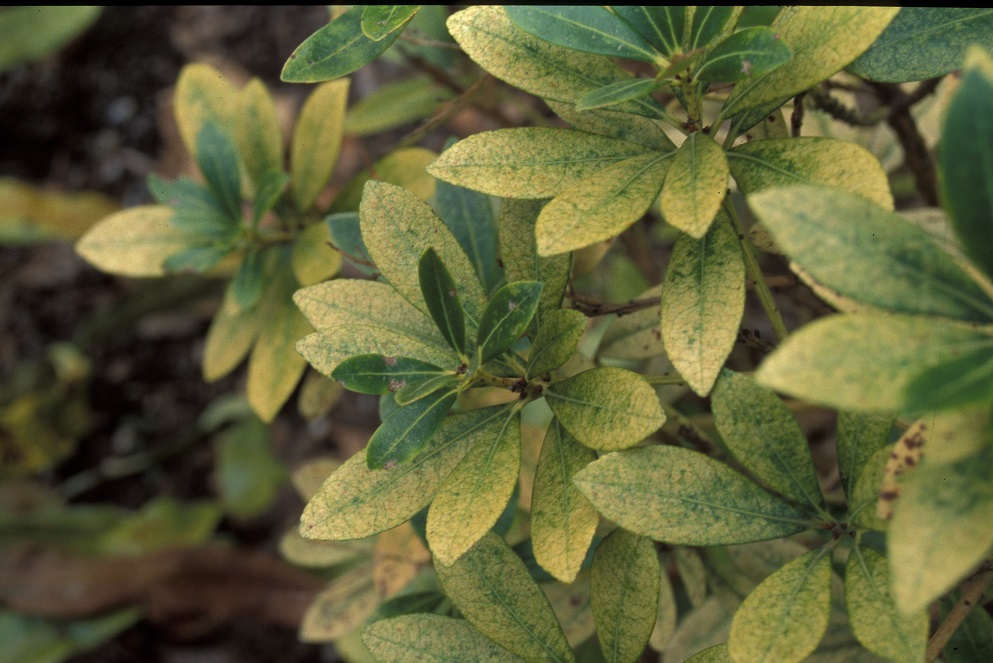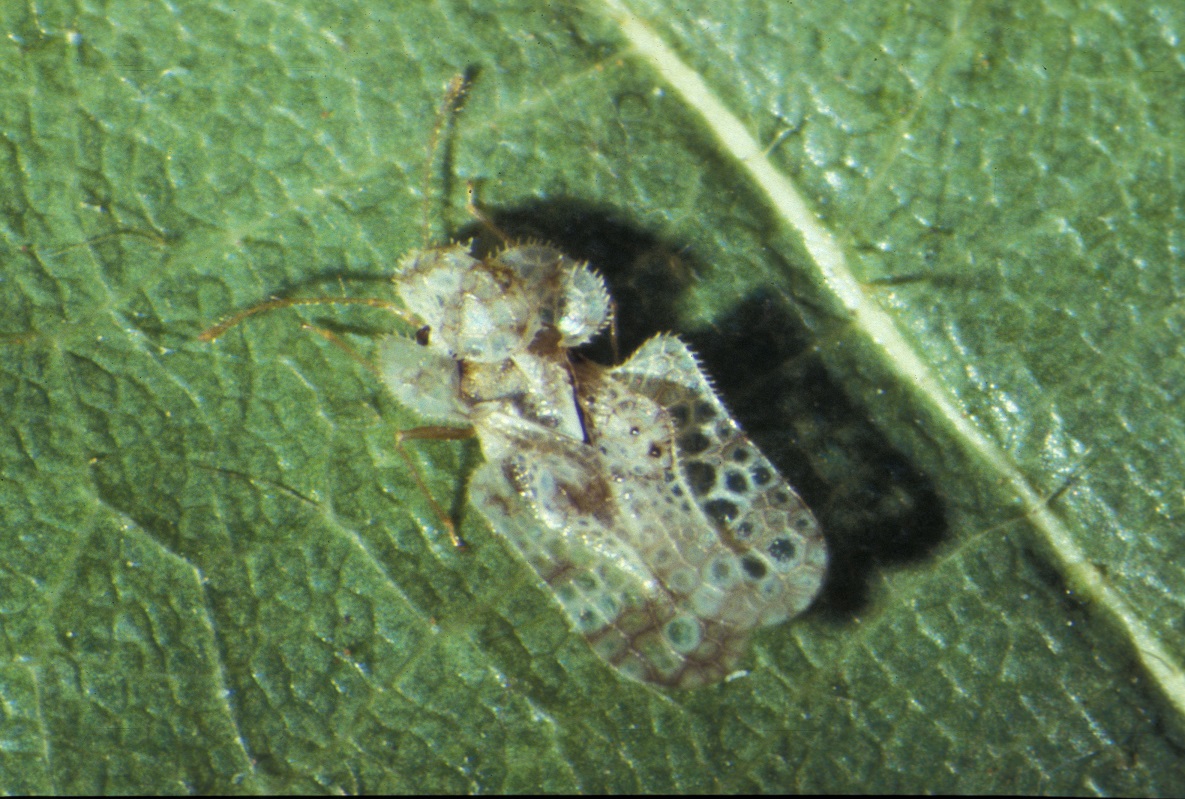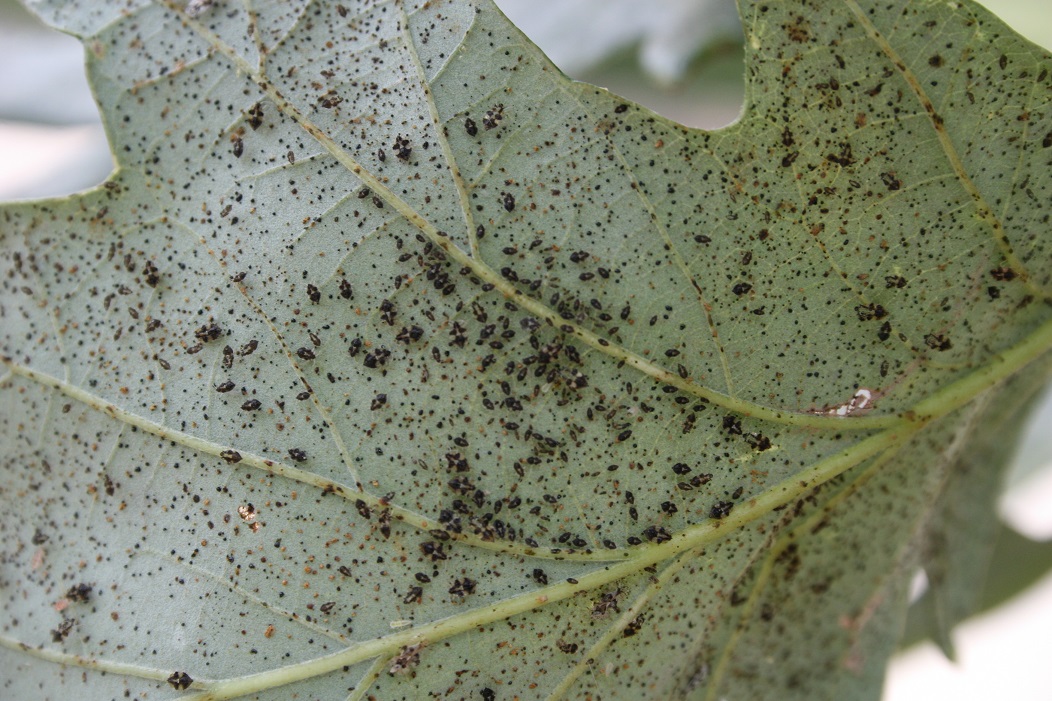–by Dr. Raymond Cloyd
Lace bugs are insects that are present throughout Kansas feeding on a variety of plant types; however, lace bugs are not really a major insect pest of garden and landscape plants because they typically do not inflict significant direct harm to plants. Nonetheless, abundant populations may reduce the aesthetic appearance of certain plant types. Lace bugs feed on a wide-range of trees and shrubs, including: azalea, basswood, cotoneaster, hawthorn, linden, oak, rhododendron, and sycamore. Herbaceous plants susceptible to lace bugs include: aster, chrysanthemum, and scabiosa. The major plant-feeding lace bug species include Stephanitis spp., and Corythucha spp. Stephanitis spp. are primarily pests of broad-leaved evergreens, whereas Corythucha spp., including the sycamore lace bug (Corythucha ciliata) are pests of deciduous trees and shrubs.
Fig 1: Lace bug damage on azalea plant. Note the stippled and/or bleached appearance of the leaves.
Lace bugs feed primarily on leaf undersides; using their piercing-sucking mouthparts to withdraw plant sap from individual leaf cells. Their feeding cause’s leaves to appear stippled and/or bleached (Figure 1). Lace bugs feed similar to the twospotted spider mite, Tetranychus urticae, with both withdrawing chlorophyll (green pigment) from plant cells. The damage associated with lace bugs is similar to that caused by spider mites and leafhoppers; however, lace bugs leave black, tar-spot-like droplets of
Fig 2: Black, tar-spot-like droplets of lace bug excrement.
excrement (“Lace Bug Poop”) on leaf undersides (Figure 2). The presence of black excrement distinguishes lace bugs from spider mites and/or leafhoppers. Excessive lace bug populations and extensive feeding may reduce plant vigor; however, any direct plant effects are dependent on plant age and size (especially young or newly-transplanted trees and shrubs).
Adult lace bugs are very distinguishable and quite attractive. The adults possess lacy, clear, shiny wings that are held flat over the body (Figure 3).
Fig 3: Close-up of lace bug adult.
They are 1/8 to 1/4 inch (3 to 8 mm) in length, and move sideways when disturbed. Female lace bugs lay between 20 to 50 eggs during their lifespan underneath leaves. The eggs are usually positioned alongside leaf veins and are black and shaped like a wine flask. Shiny, black nymphs with spines around the periphery of the body emerge from the eggs (Figure 4).
Fig 4: Lace bug nymphs on leaf underside.
Nymphs undergo five instar stages before reaching adulthood. Shed skins on leaf undersides are evidence of nymphs that have transformed into adults. The life cycle (egg to adult) generally takes about 30 days to complete. There may be up to three generations per year although development is contingent on temperature. Stephanitis spp. overwinters as eggs that are cemented onto leaves and Corythucha spp. overwinters as adults in bark crevices and branch crotches. Adult activity commences in the spring when leaves unfold.
Lace bugs are more abundant on plants such as rhododendron and azalea that are exposed to full sun rather than on plants in shady locations. The management of lace bugs is generally not warranted because lace bugs are susceptible to many natural enemies including predators; such as, green lacewings, plant bugs, assassin bugs, minute pirate bugs, and spiders. A forceful water spray may be effective in quickly dislodging lace bugs from plants. However, if necessary, a number of contact insecticides registered for use against lace bugs can be applied. Be sure to read the label to make sure lace bugs are listed. Be sure to thoroughly cover leaf undersides to maximize the effectiveness of spray applications because the leaf undersides are where all the life stages (eggs, nymphs, and adults) of lace bugs are located.
If you have any questions regarding the management of lace bugs contact your county horticultural agent, or university-based or state extension entomologist.



